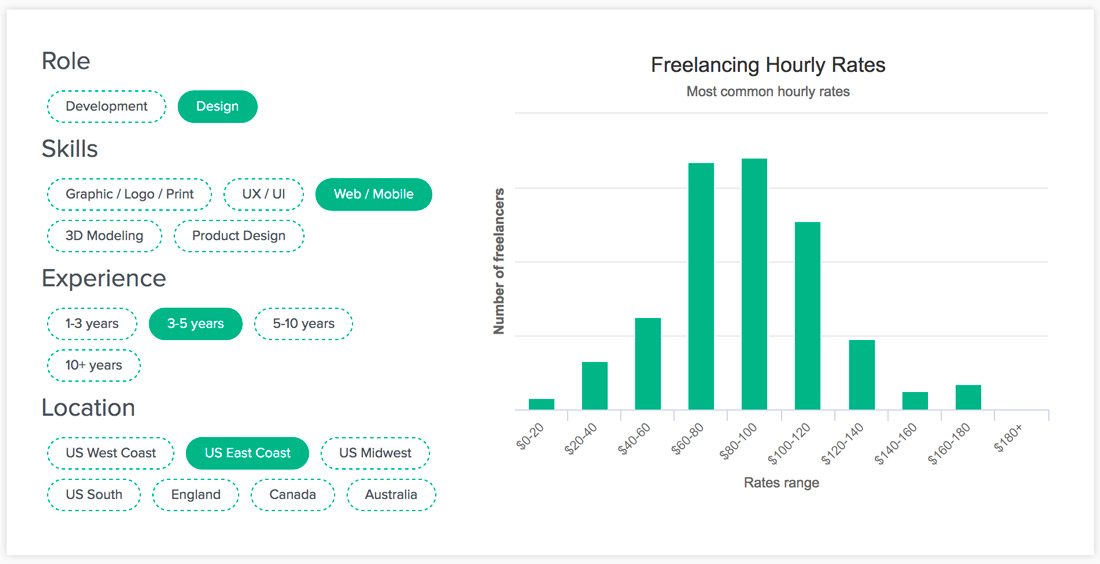How Much Should You Charge for Design Services?
It might be one of the most asked questions among freelance designers: what do you charge clients?
There can be so many variables in setting rates that you can stick to, and you have to make a choice between hourly and fixed options. Either way, a good pricing strategy can help you get the clients you want and earn a solid income from freelance work.
After you figure out pricing. Which is a challenge for almost anyone!
The Ultimate Designer Toolkit: 2 Million+ Assets
Envato Elements gives you unlimited access to 2 million+ pro design resources, themes, templates, photos, graphics and more. Everything you'll ever need in your design resource toolkit.
Set an Hourly Rate, for Starters

For most freelancers, setting an hourly rate is the place to start. It provides a baseline comparison to other freelancers in the market and is something clients can understand, as long as they are flexible with hours worked and pricing.
You can use time tracking software to keep up with exactly how much time you spend on projects – as long as you actually remember to use it and have solid focus while working on projects.
An hourly rate is great if you work at a moderate pace, take on projects that don’t shift a lot in time (clients don’t love getting revised pricing estimates) and like the flexibility of this time accounting method. On the other hand, some designers find that hourly rates hold them back because they can finish projects quickly and hours worked is not the only price consideration.
Know Your Costs
Your rate needs to reflect your costs plus take-home cash for yourself. Remember to include elements like taxes, rent and lights, software and other supplies when pricing projects. You need to be able to cover all costs before you’ll ever make any money as a freelancer.
Sadly, this is the thing that gets forgotten sometimes.
Go grab your accountant and figure out costs first time to help set a baseline for how much you need to earn.
Price Hourly or by the Project
The alternative to hourly pricing is project pricing. Project pricing is preferred by a lot of designers who have been freelancing for a while.
This might be the best case for project pricing out there from Jake Jorgovan for Career Foundry:
When you charge based on the project, you are tying the price of the project to the client’s end result. The end result is all that the client cares about.
Shifting the focus of my freelancing away from the time I worked and toward the value I delivered changed everything. It completely changed my income potential and how much I made.
Setting project rates is a little trickier. Everyone does it a little differently. (Jorgovan even suggests making it up… kind of.)
Over the years, I have developed a little more of a strategy based on market and industry rates, creative flexibility with the project, client budget and potential long-term value, timeline and how I “feel about it” from the start.
- Market and industry rates: What are others charging for similar services in your market? I tend to price well below agency pricing – I am a team of one and can’t provide the round the clock services of a full team – and in the middle of what other freelancers in my market charge based on how long I’ve been in the business.
- Creative flexibility: The dirty secret is that I charge a little more for dud projects. No client will ever know who they are, but I do quote a little lower for a project that I really want to stretch my creative muscles. It helps me grow and expands my portfolio for later. The routine stuff gets more routine pricing.
- Client budget and value: An accountant once said to me, charge every client what they are willing to pay. It took a while to really get this, but it all comes back to value. What is the project worth to them? The client is coming to you for your value and expertise. Price accordingly to show that your work is valuable. (A $5 logo never said “value” to anyone.)
- Timetable: A project with a super-fast turn around is worth more to a client than something they need in 6 months. Think about scheduling to ensure that you can get it in and get it done on time. Think about whether you will have to price more to account for other projects getting bumped back.
- The “feel:” Check your gut when you meet with a client for the first time. Do they know what they want? Or will they waffle? Clients that will require a lot of hand-holding along the way will take a lot more of your time for the same work. You should probably charge a little more here.
The biggest problem with project rates is that sometimes you’ll get it wrong. There are projects that will suck up your time and frustrate you to no end because you just estimated wrong. If this happens frequently, then you are an hourly rate kind of freelancer. If it only happens once in a while, project rates can be a great option.
Pro tip: Use a combination of project and hourly rates. Opt for hourly rates for small projects (or friends and family if you dare work with them) that will come in under $250. This includes simple logo design, a business card or poster for clients that you know and will almost always take the design as is with a few minor revisions. Use project rates for anything that requires a lot of setup or time, such as website redesigns, branding or large packets of information.
Include Contingencies

No matter what pricing structure you use, make sure to include a scope for each project and room for contingencies in the estimate.
Include some rules with client estimates to keep scope creep from eating away at potential earnings.
Include guidelines for:
- What exactly the project entails, such as one website design with up to 10 pages.
- Number of revisions included.
- Rate for changes beyond the scope.
- Payment guidelines; this is vital for big projects or large timelines where you might need to get some of the money up front.
- Any additional fees, such as late charges, processing later or maintenance or upsells.
So What Should I Actually Charge?

As you can figure from all the information above, there’s no magic formula.
Price too low and you’ll worry about making enough money to pay the bills. (You can also run the risk of having too many clients because of underpricing.)
Price too high and you might have trouble getting projects.
You want to be somewhere in the middle, where you can take the clients you want and refer others elsewhere. And so much of it matters where you live and where the clients are based.
Contently has a solid database of freelance rates for writing, design and photography so you can see what people are actually getting paid. (Plus you can sort by category, rate or date.)
Bonsai also has a rates database that you can put in options such as design or development, skills, experience and location to get an idea of what hourly rates look like.
It can be tricky. The good news is that when you figure it out, you’ll know because your client mix will feel just right with a few large project, a few small projects and rewarding work.
Conclusion
OK, so maybe you did not get the exact answer you wanted. I could have told you to charge everyone $75 per hour for any project. But that would be a disservice to you.
It’s all about how you work and your client relationships. Feel them out. Understand their needs and work with clients to find just the right pricing strategy.
Freelancing 101 is an occasional series to help the increasing number of freelancers in the market. Whether you are a designer, writer, developer or wear multiple hats, we will share tips, resources and ideas to help you make the most of your small business. Is there something in particular you want to know? Let me know at [email protected].
Creative commons photos by Death to the Stock Photo .


